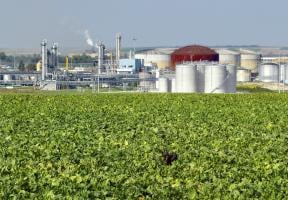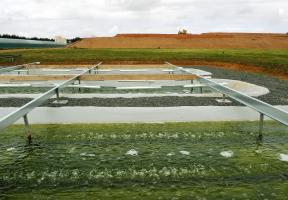Dealing with Deforestation
10 min read
Deforestation is continuing in many of the world’s regions, even if it has slowed somewhat in the last three decades - proof that the efforts made are effective. It reduces the carbon capture capacity of plants and soil and makes it harder to fight against . Agribusiness, the local populations’ need for farmland, and fires are the main causes of deforestation. What can be done to fight against it?

© THINKSTOCK - Deforestation continues worldwide, albeit at a slower pace, as land is cleared for farming, wood is used for energy and fires destroy forests.
Forests and Climate Change
Forests cover over 30% of the planet’s landmass, i.e. more than 4 billion hectares[1]. They protect , soil and water resources, and are the Earth’s biggest carbon “absorber”. They “capture” the equivalent of 33% of global CO2 emissions every year, and are a real asset when it comes to reaching carbon neutrality.
However, persistent deforestation is compromising this absorption capacity, as combustion and decomposition produce additional greenhouse gas emissions. These emissions account for 11% of annual anthropogenic sources of CO2. Sustainable forest management is therefore a key component to fight against climate change.
Deforestation Trends
The FAO (United Nations Food and Agriculture Organization) defines deforestation as the loss of forest areas, whether it is caused by anthropogenic activity or not. It estimates that 420 million hectares of forest (equivalent to the surface area of the European Union) worldwide have been destroyed by deforestation since 1990, i.e. over 10% of the total woodland area.
Thankfully, two factors help offset this worrying fact:
- Over the decades, the pace of deforestation has significantly decreased. From an average of 15 million hectares per year between 1990 and 2010, it dropped to 12 between 2010 and 2015 and then to 10 between 2015 and 2020.
- Forestland has gained ground, either through natural regeneration or intentional reforestation. By weighing up the losses and gains, the FAO defines the “net change” in forest area. The loss is now only 4.7 million hectares per year for the period between 2010-2020.
Deforestation Across the Continents
The destruction of tropical forests accounted for 90% of global deforestation between 2000 and 2020. Africa shows the highest levels of forest loss, and the situation is getting worse. South America is also significantly affected, but the “net change” is improving. Asia, however, shows a net gain in forest area between 2010 and 2020. Developed countries, generally located in temperate climates, underwent deforestation several centuries ago. The situation has now stabilized and some countries, such as France, have increased their forested areas.
The Amazon Rainforest
The Amazon rainforest, a global symbol of the primary forest, is doing better. In 2023, 5,000 km2 were destroyed compared to 10,000 km2 in 2022. It is the lowest level of deforestation since 2018, but still a long way off the “zero deforestation” objective for 2030. Environmental associations like Greenpeace are also warning against the risk of moving industrial activities - in particular soy cultivation - to other extensive natural areas like the Cerrado, a huge tropical grassland in south Brazil, covering an area equivalent to half the European Union.
The Responsibility of Agribusiness
Deforestation is mainly due to wood harvesting and the clearing of woodlands for other uses such as agriculture and livestock farming. The spectacular forest fires in California and Australia play a lesser, although growing, role.
According to the FAO, the expansion of farmland is the cause of almost 50% of global deforestation. Oil palm alone caused 7% of global deforestation between 2000 and 2018. Grazing land for large cattle ranches accounts for 38.5% of deforestation.
In Latin America, and especially Brazil, forests are being pushed back by huge soy and corn farms and cattle ranches.
In central Africa, small subsistence farms are the main culprit, with slash-and-burn techniques carving out new plots from the forest or grasslands each year.
In Southeast Asia, and Indonesia in particular, vast oil palm plantations are the main cause of deforestation. Palm oil is used in the food industry and to produce biofuels. Although the European Union (EU) has issued rules on , notably concerning reforestation, and Indonesia has adopted criteria, they have not been able to fully rein in illegal operations.
The need for farmland is doubled by the fact that, in developing countries, wood-derived fuel is the main source of energy for an impoverished population of over 2 billion. In Africa, more than 90% of cut wood is used for energy.
The Solutions
The best solution is to reduce deforestation or stop it altogether. Otherwise, the most effective action is reforestation, by developing what the FAO refers to as "plantation forest”, an intensively managed planted forest with trees of one age-class and with regular spacing. Plantation forests cover around 131 million hectares, i.e. 3% of the world’s forested areas.
At international level, the United Nations has launched Reducing Emissions from Deforestation and Forest Degradation (REDD) and REDD+ programs.
These programs focus on measures that encourage businesses and communities to farm without encroaching on forests, for example by improving crop yields, or using forest products sustainably, without degrading woodland areas.
Reforestation, which has been extensively applied in China, is a useful technique, but it should not divert the focus from “avoiding deforestation” in the first place. One reforested hectare does not equal one deforested hectare, as in most cases the reforested area does not have the same quality as a natural forest in terms of variety of species and protection of biodiversity.
[1] Remember that 100 hectares = 1 km2. The forest therefore covers 40 million km2
Sources:
Visit the FAO’s interactive website.
Look at the satellite map created by the University of Maryland.





















